 I have been told that a wine refractometer works real nice as an alcohol tester for my wine must and also at the end is this true?
I have been told that a wine refractometer works real nice as an alcohol tester for my wine must and also at the end is this true?
Gary
—–
Hello Gary,
Thanks for the great question. Testing the alcohol level of a wine is a subject that always seems to have some confusion among home winemakers.
A refractometer can not be used as an alcohol tester for wine. It will not test the alcohol level. A refractometer will only test the sugar level of a wine must or finished wine. This is no different than what a wine hydrometer can actually do. They both measure the sugar in a wine, not the alcohol.
By comparing two sugar level readings, one taken before the fermentation and another after, you can determine how much alcohol was made. This is because wine yeast consume sugar and turn some of it into alcohol. If you know how much sugar was consumed by the wine yeast, you can then determine how much alcohol was made.
This principal is exactly the same for a refractometer as it is for a hydrometer. Neither are alcohol testers, but they will allow you to calculate the alcohol level of a wine must or finished wine by comparing a current sugar reading (brix) with a beginning reading.
What makes the refractometer extremely useful — and more handy than a hydrometer in some cases — is that you can take accurate sugar readings with very small liquid samples — just a couple of drops is all that is needed. This makes it ideal for checking the ripeness of the grapes while out in the vineyard. You only need to squeeze the juice from a single grape to see how sweet the grapes are becoming. This is very valuable when trying to determine when to pick your grapes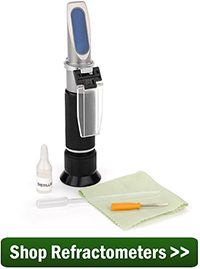 .
.
Alternately, the hydrometer needs enough sample for it to float. This could take as much as 4 or 5 ounces of wine or must. A hydrometer jar is also needed to hold the sample. So as you can see more time and effort is involved to take a reading with a hydrometer. This pretty much rules out taking a sugar reading on the fly as you might with a refractometer.
Gary, to answer your question more directly, a refractometer is a great tool for any winemaker to have. It is very handy, and it provides a quick way to get a sugar reading almost anytime, anywhere. But a wine refractometer is not an alcohol tester. It will not directly give you the alcohol level of your wine. This can only be done by comparing a beginning reading (before fermentation) with a current reading.
Happy Wine Making,
Ed Kraus
—–
Ed Kraus is a 3rd generation home brewer/winemaker and has been an owner of E. C. Kraus since 1999. He has been helping individuals make better wine and beer for over 25 years.
Category Archives: Home Wine Making
3 Refreshing Wine Cooler Recipes that Will Get You Excited for Summer
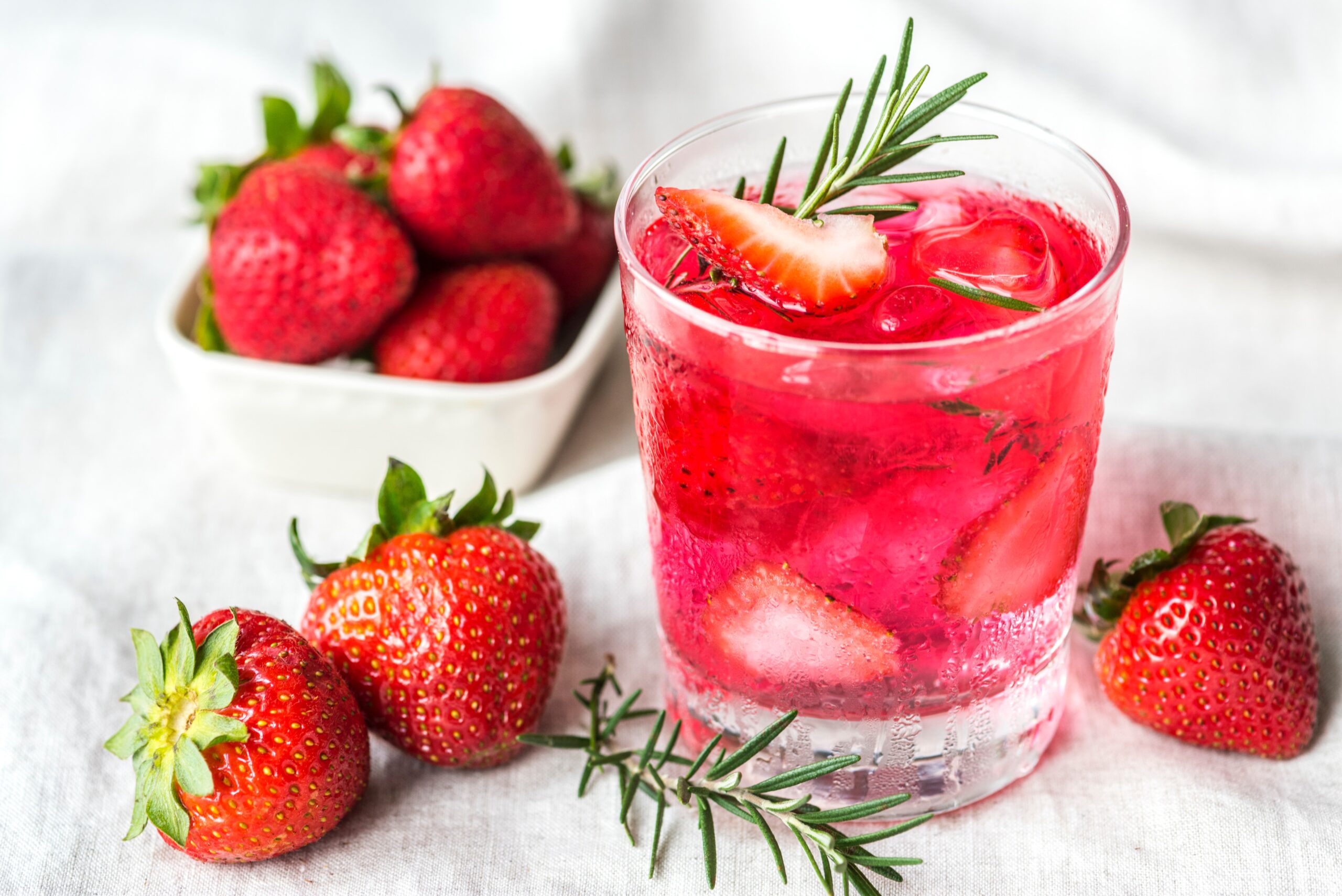 Summer is right around the corner and there is nothing sweeter, or more refreshing, than a nice homemade wine cooler during the scorching months of the year. Here is a recipe that is quick and tasteful for any wine lover. This recipe can also be interchangeable with any of our wine recipes to add more flavor to your cooler.
Summer is right around the corner and there is nothing sweeter, or more refreshing, than a nice homemade wine cooler during the scorching months of the year. Here is a recipe that is quick and tasteful for any wine lover. This recipe can also be interchangeable with any of our wine recipes to add more flavor to your cooler.
Whether its laying by the pool or enjoying a drink with some friends in the evening- here are three wine cooler recipes that will have your taste buds thanking you:
Tropical Pineapple Twist Cooler
Ingredients:
- 4 oz. of wine (Recommended: Our Pineapple Wine Recipe)
- 1 oz. pineapple or cranberry juice
- 2 oz. club soda
- Slice of lime
Directions:
Combine the wine, juice, and club soda. Fill a tall glass with ice and a lime wedge and then pour the contents of your drink and enjoy. The serving size is for a single glass but can be modified with a higher quantity of ingredients for a larger serving size.
This recipe is simple and takes little to no time unless you decide to chill the finished product for a few hours. Club soda will add a nice carbonated fizz to your cooler and our pineapple wine recipe will enhance the fruit flavor and give a more distinct taste. Other wine suggestions include a dry Riesling or pinot grigio. If you decide to use the pineapple wine recipe, cranberry juice can offset the pineapple but boost the citrus taste.
Strawberry Banana Refresher
Ingredients:
- 2 cups strawberries
- 750 ml. bottle of wine (Recommended- banana wine recipe or sauvignon blanc)
- 1/3 cup sugar
Directions:
Mix together the strawberries and sugar and let them sit for 10-15 minutes. In a blender, puree the strawberries until smooth and add the bottle of wine. Once the mixture is smooth and well blended pour contents into a large glass and serve chilled over ice. You can also add cut up strawberries or blueberries to enrich the flavor and the appearance. These ingredients make up to 4 servings.
Adding the banana wine recipe to this Strawberry Banana Refresher adds to the bare strawberry puree and combines the flavors to have you going back for more. Strawberry Banana is a classic combo and trying out this homemade recipe will have you feeling rejuvenated and confident to test out new recipes on your own.
Ginger Lime Cooler
Ingredients:
- 4 oz. wine (Recommend Ginger Root Wine or White Wine)
- 1-part lemon-lime soda
- 1-part Ginger ale
Directions:
Mix all three ingredients and let chill in refrigerator. Once mixture is cool, serve over ice and enjoy. Ingredients yield 1 serving.
This quick fixture is a take on the modern Moscow Mule (without the vodka, obviously). Our ginger root wine recipe adds tang to the creation and is balanced with the combination of ginger ale and sprite. This option is not as sweet as the Tropical Pineapple or Strawberry Banana, so it aids as a nice refreshing drink for those who enjoy a less fruity cocktail.
These fresh wine cooler recipes are great cocktails to serve when friends and family are over and will save you from the summer heat. If you are new to wine making or want to branch out from the recipes provided, check out our homemade wine options for a larger variety to include in your wine coolers.
Are there any wine cooler recipes that you recommend? Please share in the comments below!
How Long Does It Take To Make Wine?
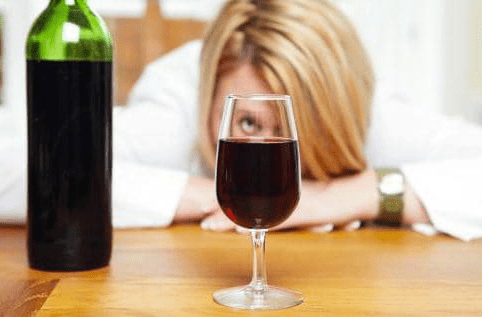 One of the more common questions we get asked by beginning winemakers is, how long does it take to make wine? And most often they begin to show signs of excitement after we explain to them that it does not take nearly as long to make as they think to make a good batch of wine. In fact, it is very possible to have a wine bottled within a month from the time you begin the wine making process.
One of the more common questions we get asked by beginning winemakers is, how long does it take to make wine? And most often they begin to show signs of excitement after we explain to them that it does not take nearly as long to make as they think to make a good batch of wine. In fact, it is very possible to have a wine bottled within a month from the time you begin the wine making process.
Once the wine has been bottled there are some benefits to aging, but a remarkable amount of the improvement can be obtained within the first 30 to 60 days of bottle aging, so it is possible for you to have a very delectable wine within 2 to 3 months from the time you start making wine.
How long it actually takes to make wine depends on what you are using to make the wine. Are you making your wine from grapes? Are you making you wine from fruits? Are you making your wine from wine ingredient kits?
Packaged wine making juices tend to make wines faster than making wine 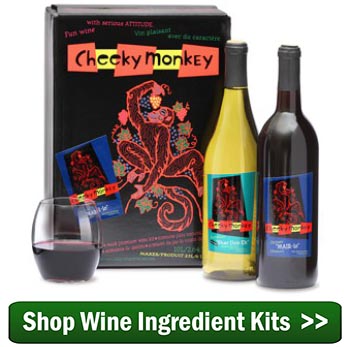 using fresh fruits. This is primarily because there is no pulp or skins involved. The concentrated juices clear up much faster, allowing the wine to be bottled much sooner. Wine ingredient kit have there own wine making recipes included with them, so it makes it a good option for the first-time winemaker.
using fresh fruits. This is primarily because there is no pulp or skins involved. The concentrated juices clear up much faster, allowing the wine to be bottled much sooner. Wine ingredient kit have there own wine making recipes included with them, so it makes it a good option for the first-time winemaker.
So, How Long Does It Take To Make Wine?
Here is an overview of what to expect based on what is being used to make the wine:
- Winemaking Ingredient Kits:
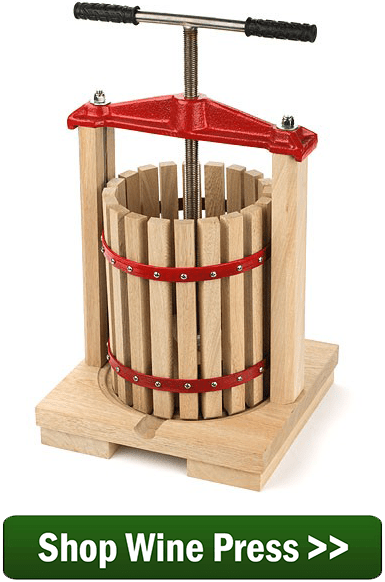 If you are making a wine from one of our winemaking ingredient kits you will be bottling your wine in about 4 to 6 weeks, depending on which brand of wine making kit you are using.
If you are making a wine from one of our winemaking ingredient kits you will be bottling your wine in about 4 to 6 weeks, depending on which brand of wine making kit you are using.
- Winemaking Caon Concentrates:
When using winemaking can concentrates such as SunCal, Alexander or Country Fair, you will be bottling your wine in 6 to 10 weeks.
- Fresh Fruits:
Because of the pulp involved, it takes longer to make wine using fresh fruits or grapes than it does using packaged juices. Aging can take a little more time as well because of the higher level of tannins and other proteins that are typically in the wine must from the fresh fruit. You can expect to be bottling your wine in about 8 to 12 weeks from the time you started the batch, and also anticipate needing to bottle age the wine at least 3 to 4 months, and sometimes up to a year, depending on the fruit.
The amount of time it takes to make a batch of wine can vary somewhat based on the scenario, but all in all, the time needed is usually less than expected. Start off with one our California Connoisseur ingredient kits, and you’ll be drinking wine in 28 days. Or, maybe you have some fresh fruit growing out back. In that case you may want to get our Your Fruit! Necessities Box. Wine making recipes are included.
—–
Ed Kraus is a 3rd generation home brewer/winemaker and has been an owner of E. C. Kraus since 1999. He has been helping individuals make better wine and beer for over 25 years.
Wine of the Month: Apple Wine
Apple wine, also commonly referred to hard cider, is one of the oldest fermented beverages in the United States. This crisp, sweet wine can be made from fresh apples, apple concentrate, or even apple cider. Even better, October is the perfect time to pick apples from your local orchard. Fall is a great time to make this wine. Read on to find out more about apple wine, along with our exclusive recipe and wine pairing tips.
Continue reading
Wine of the Month: Pear Wine
Our wine of the month is pear wine. This lightly colored, sweet wine packs in the nutrients given the healthful properties of its main ingredient: pears. In addition to a delicious recipe, we’ve got some useful tips so you get the most flavor out of your wine.
Why should I make pear wine?
Pears are a member of the rose family of plants and are chockfull of antioxidants, dietary fiber, and flavonoids. In fact, about half of the fiber found in the pear can be found in its skin. The phylonutrients contained in this delicious fruit not only contain antioxidants and anti-inflammatory flavonoids, but also contain cinnamic acids that can help prevent cancer and decrease the risk for Type 2 Diabetes. Pears, along with apples, are known to have the second highest number of flavonols among all fruits and veggies.
Now let’s get to the wine part. Due to the fact that pear wine is a fruit wine rather than a grape wine, it has a higher ORAC content. In short, this means that it’s winning the antioxidant game. We’ll cheers to that!
Recipe:
Makes about 5 gallons
20lbs of Pears
10 lbs. of Sugar
1 tbsp. of Yeast Energizer
1/2 tsp. of Pectic Enzyme
3 tbsp. of Acid Blend
1/2 tsp. Wine Tannin
Yeast EC-1118
There are a few things to keep in mind while you’re making your pear wine. For the best results, you should slightly over ripen the pears. This is key, because they aren’t an extremely flavorful fruit by nature. If you don’t let them ripen, the wine will have more of an apple flavor. Let them get extremely soft (without rotting) and you’ll set yourself up for success. Also ensure that you rinse your pears before you crush them.
Where and how can I find pears?
The state of Washington is the largest grower of pears in the United States. It accounts for half of all of the pears distributed in the country, followed by California and Oregon. Most of the pears found in US grocery stores fall into the European Pear category. They can be found in green, yellow, red, gold, and brown. Once you find them at the grocery store, you’ll need to give them a few days to ripen. Just make sure you watch them carefully, because once they ripen, they tend to perish quickly. It can be hard to determine ripeness because many pears do not change color as they ripen.
What foods does pear wine pair best with?
Given pear wine’s light and refreshing taste, it pairs well with bold and flavorful cheeses like blue cheese and goat cheese. Spread some cheese on a cracker and sip some pear wine in between for the perfect pre-dinner snack. As for main courses, pear wine tastes great with white meats, either baked or roasted. Finish off the meal with a fruit or nut-based dessert and you’ve successfully and deliciously paired your pear wine!
Ed Kraus' Wine of the Month: Concord Grape
Our wine of the month is Concord grape. Native to North America and also known as a “backyard garden grape,” it is the most popular grape in the country. Named after Concord, MA, where it was originally grown, the Concord grape is rich and full-bodied in flavor. Although you can commonly find this fruit in jams, jellies, and juices, it’s time to kick things up a notch. Discover our wine recipe for Concord grape wine and reap all of the delicious benefits.
Why should I make Concord grape wine?
This dark-skinned grape variety, a.k.a. the fox grape, contains high levels of anthocyanin and resveratrol. Resveratrol is an antioxidant and phytochemical that can produce many skin benefits. In addition to protecting skin from UVA and UVB radiation and damages caused by sunburn, it is also known to lower the risk of skin and breast cancer. In fact, purple and blue grapes are known to contain the highest amount of antioxidants of all of the varietals, making them extremely beneficial to cardiovascular health and the prevention of degenerative diseases.
Wine Recipe:
40 lbs. of Grapes
6 ½ lbs. of Sugar
2 tbsp. of Yeast Nutrient
¾ tsp. of Pectic Enzyme
1 tbsp. of Acid Blend
1 tsp. Wine Tannin
Yeast 71B-1122
You can find easy directions to making wine on our website. While you’re making the recipe, keep in mind that these are “slip skinned” grapes, meaning that their skins slip off easily. Oftentimes, the flavor of the skin is described as “foxy,” so you may want to remove the skins, dilute the grapes, and press the juice before you add yeast to avoid any chance of a chemical-like taste to the wine. Also note that Concord grapes are higher in acid and lower in sugar than wine grapes, making it a bit more challenging when it comes to winemaking. But hey, who doesn’t love a challenge?
Where and how can I find Concord grapes?
You’ll have the most luck finding Concord grapes in the northern climates. Major growing areas include the Finger Lakes, Lake Erie, Lake Ontario, Southwestern Michigan, and Yakima Valley. Look for darker, larger grapes because table grapes are a bit loftier than wine grapes.
What foods does Concord grape wine pair best with?
Concord grape wine’s aromatic and robust flavor makes it a suitable partner for both sweet and salty dishes. It can be paired with other strong flavors like sharp cheddar and goat cheeses or can be used to complement lighter flavors like fish and chicken. Don’t forget to save room for dessert, either, because Concord grape wine couples deliciously well with chocolate.
Regardless of what you choose to pair Concord grape wine with, make sure you enjoy every sip of this foxy, flavorful beverage.
Our Favorite DIY Wine Rack Tutorials From Around the Web
What better way to display your last batch of homemade wine than a wine rack? We scoured the web and found our favorite DIY versions from fellow wine lovers. We hope to share some DIY inspiration for showing of the fruits of your labor: Continue reading
Environmentally Friendly Ways to Make Wine
Making your own wine is a great way to lead a more sustainable lifestyle. There is no better way to ensure that the wine you drink is healthy for both you and the environment, than making it yourself. Making homemade wine give’s you control of the process, from picking ingredients to corking each bottle. You can ensure the ingredients and supplies you are using are eco-friendly and do not contain any unknown chemicals or preservatives. Continue reading
You Should Be Making Your Own Wine
Recently, many studies have indicated wine drinkers experience health benefits such as, lower mortality rate, reduced risk of heart attack, reduced risk of chronic disease such as Type 2 Diabetes, and slower brain decline. But, did you know making wine has benefits as well? Let’s explore some ways that making wine is beneficial to your overall wellbeing: Continue reading
Our Top 5 Favorite Wine Labels
Whether it is your first time making wine or you are an experienced wine maker, personalized wine labels are a great addition to any bottle of wine. Wine labels can be used to create your own unique brand or you can create custom gift labels for a variety of occasions. We put together a collection of our top 5 favorite DIY label ideas from around the Internet to give you some inspiration for your next batch of homemade wine.
Continue reading
